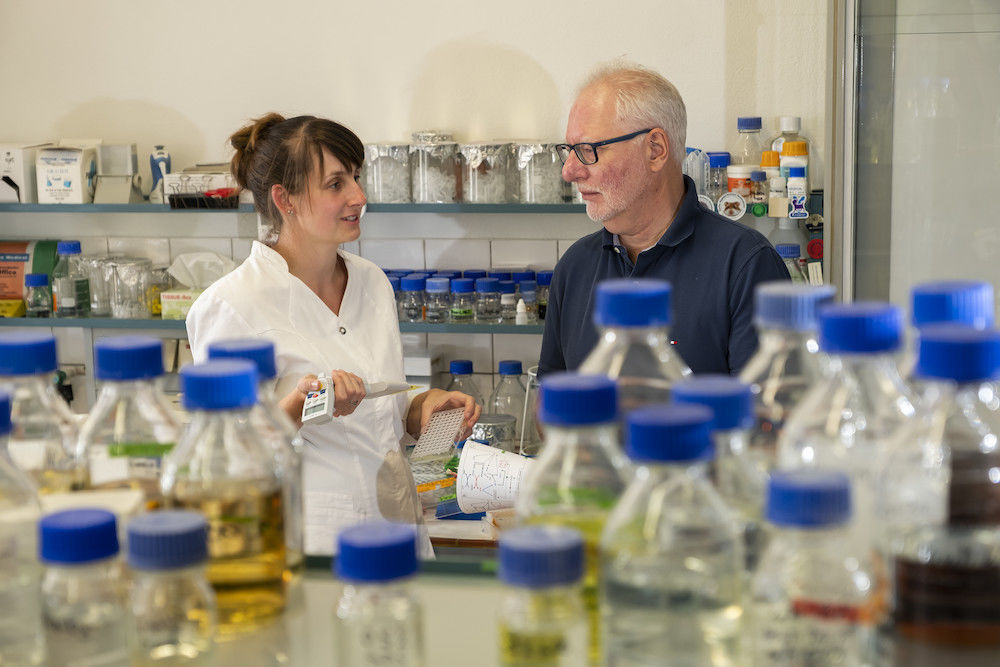The tiny philosopher’s stone

When Dietrich Nies began working on his doctorate in 1982, he had no idea that one tiny microorganism would accompany him throughout his entire scientific career. Back then, the bacterium, commonly known today as Cupriavidus metallidurans, was simply called “CH34”. It was first discovered in the wastewater of an old zinc smelting plant in Belgium in the 1970s. “It is actually a normal bacterium,” explains Nies. It neither causes disease nor is it restricted to specific biotopes. It has been found all over the world, especially in places that are contaminated with heavy metals. “However, it isn’t present in the copper dumps here in Saxony-Anhalt,” adds Nies. Perhaps the soil is too acidic.
The special thing about the bacterium is that it has metal resistance genes that enable it to survive in what are actually toxic environments. While working on his doctorate in Göttingen, Nies identified and isolated these genes. His work also took him to the University of Illinois in Chicago, USA and to the Free University of Berlin. There he did his habilitation on the metal resistances in C. metallidurans. In October 1993 he was appointed Professor of Molecular Microbiology at MLU. His research on the microscopic “survival artist” accompanied him to Halle. But at the time his work had little to do with gold.
And that would probably have remained the case had it not been for Frank Reith, a German microbiologist living in Australia. Reith conducts research on alternative methods for finding new gold deposits in the gold-rich country. In 2006, he raised a stir when he was able to prove for the first time that one bacterium is always present in the biofilm on gold: C. metallidurans. Reith wanted to understand this in more detail and contacted Nies. Initial discussions led to joint projects, “a series of nice publications” in distinguished journals, and several projects funded by the Deutsche Forschungsgemeinschaft (DFG).
Nies explains that the question of how and why the bacterium produces harmless nuggets from the toxic gold particles in the soil was initially a “side project” for him. A project that, at the beginning, did not always meet with success. “2012 was a time of complete confusion as to what the results meant,” he says, laughing. His work on other metal resistances, in combination with Reith’s geomicrobiological work, was intended to help decode the metabolism of gold.
In order to understand this, one needs to look at the bacterium’s biotope. It mainly lives in soils that are enriched with heavy metals. Over time, some minerals in the soil wear down and release toxic heavy metals and hydrogen into the environment. Hydrogen and oxygen react to release energy that C. metallidurans can use. At the same time, it must extract important trace elements, like copper, from the heavy metals without poisoning itself.
The bacterium uses various enzymes to keep its heavy metal balance in check. First, the copper is converted into a form that is easier for the bacterium to absorb. Then the excess copper is normally pumped out again by the enzyme CupA. Gold enters the bacteria in the same way as copper - and this poses a problem: “CupA cannot function when gold compounds are present inside the bacteria. The copper and gold compounds remain inside the cells, poisoning the organism,” explains Nies.
To solve this problem, C. metallidurans activates another enzyme: CopA. It is able to convert the copper and gold compounds back into forms that are more difficult to absorb. “This prevents fewer copper and gold compounds from entering the interior of the cell and CupA is free to pump out and dispose of excess copper,” explains Nies. This produces a fascinating by-product: in the outer area of the cell, the gold compounds are transformed into harmless gold nuggets a few nanometres in size.
The scientists published the results of their years of work some time ago. However, gold research on C. metallidurans has yet to conclude. A newly approved DFG project will look at another unsolved question: How does the harmless gold exit the bacterium? “We want to find out whether there is a mechanism that actively excretes the gold grains when too many of them have formed in the periplasm,” explains Nies. A small alchemist that produces too much gold and has to actively excrete it? Just leave it to the researchers.
Professor Dietrich H. Nies
Institute of Biology / Microbiology
Telephone: + 49 345 55-26352
Mail: dietrich.nies@mikrobiologie.uni-halle.de
